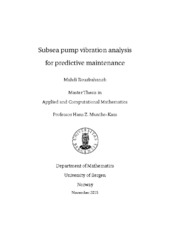| dc.contributor.author | Rouzbahaneh, Mahdi | |
| dc.date.accessioned | 2016-03-15T16:00:18Z | |
| dc.date.available | 2016-03-15T16:00:18Z | |
| dc.date.issued | 2015-11-29 | |
| dc.date.submitted | 2015-11-29 | eng |
| dc.identifier.uri | https://hdl.handle.net/1956/11666 | |
| dc.description.abstract | The goal of this study is to compare vibration signals of subsea pumps from two different time periods. These signals are gathered for predictive maintenance reasons. Vibration analysis is one of the most efficient tools for machine diagnostics. Vibration analysis has been an active area of research in the past few decades. In this thesis an attempt has been made to cover all the common vibration analysis methods to find more reliable results. Since a pump includes many rotating components, presence of a kind of periodicity is expected in the vibration signal. Local defects in each cycle of rotation cause an impulse in the vibration signal. Therefore high impulsivity in the vibration signal is an indicator of fault. This Impulsivity is not clearly observed in the vibration signal. The impulse response function of the transmission path deforms an impulse in the source into a spread segment in the vibration signal. Furthermore the impulses are more hidden when the period of impulses is shorter than the width of the impulse response function. Detection of impluses is more subtle due to the presence of background noise. Our methods mainly focus on these two obstacles to achieve impulsivity of source signal. These Impulses also appear as amplitude modulation on the high resonant frequency of the pump. In general, there is low signal-to-noise ratio in low frequencies. Therefore we look into demodulation in high frequencies to find impulses. Several methods were applied on the signals object to 1) Separation of deterministic and non-deterministic parts of signal. 2) Separation of source signal and transmission path function. 3) Determine the optimal resonant frequency band and envelope analysis. In addition a new method to estimate the shaft speed from the vibration signal is proposed. Two segments were chosen from the old and new vibration signals for analysis. We used Minimum Entropy Deconvolution (MED) and Cepstrum Analysis to remove the transmission path effect from the vibration signal. We also used Time Synchronous Averaging (TSA), Autoregressive Filter (AR), Discrete/Randome Separation (DRS) and Cepstrum Analysis to separate deterministic components from non-deterministic components in the vibration signal. The latter resolves the first problem and former resolves the second one. Band-Pass Filtering, Wavelet Packet Transform (WPT), Hilbert-Huang Transform (HHT) and Spectral Kurtosis (SK) were used to detect excited resonant frequency for Demodulation and Envelope Analysis. High kurtosis is a measure of high impulsivity in a signal. Therefore all of our methods rely on kurtosis. The results demonstrate that the Minimum Entropy Deconvolution is a very effective method to remove the transmission path effect such that the defect impulses of the source can be clearly observed. A combination of wavelet and HHT as an Improved-HHT is a highly reliable method to detect the excited resonant frequencies. Spectral Kurtosis is an efficient and direct detector of the excited resonant frequencies. Cepstrum Editing or Liftering is a multi-purpose method for each stage. A new kind of cepstrum editing with a satisfactory output has been performed. Order Tracking is performed before Time Synchronous Averaging and Discrete/Random Separation and in this study there is no tachometer signals to order tracking. Therefore these methods were not effective. After examination on the old signal only the 5th and 27th harmonics of the shaft speed had a high amplitude. These frequencies are indeed the natural frequencies of the pump and do not indicate a fault. On the other hand, the new signal led to many peaks. The strongest of these peaks were the shaft speed harmonics and 1/2 harmonics. Lack of information on the pump specifications disables us to relate these peaks to specific faults. But these harmonics are generally presented in mechanical looseness. | en_US |
| dc.format.extent | 5545039 bytes | eng |
| dc.format.mimetype | application/pdf | eng |
| dc.language.iso | eng | eng |
| dc.publisher | The University of Bergen | en_US |
| dc.subject | Pumper | nb |
| dc.subject | Undervannsteknologi | nb |
| dc.subject | Vibrasjoner | nb |
| dc.title | Subsea pump vibration analysis for predictive maintenance | en_US |
| dc.type | Master thesis | |
| dc.rights.holder | Copyright the Author. All rights reserved | en_US |
| dc.description.degree | Master i Anvendt og beregningsorientert matematikk | en_US |
| dc.description.localcode | MAMN-MAB | |
| dc.description.localcode | MAB399 | |
| dc.subject.realfagstermer | https://data.ub.uio.no/realfagstermer/c008841 | |
| dc.subject.realfagstermer | https://data.ub.uio.no/realfagstermer/c009490 | |
| dc.subject.realfagstermer | https://data.ub.uio.no/realfagstermer/c006883 | |
| dc.subject.nus | 753109 | eng |
| fs.subjectcode | MAB399 | |
